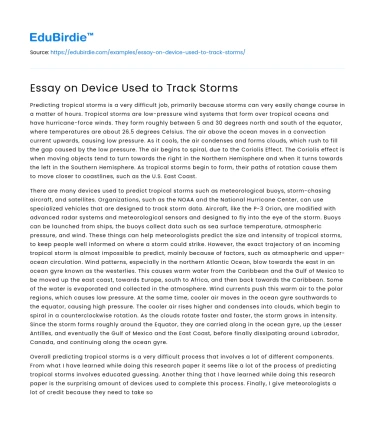Predicting tropical storms is a very difficult job, primarily because storms can very easily change course in a matter of hours. Tropical storms are low-pressure wind systems that form over tropical oceans and have hurricane-force winds. They form roughly between 5 and 30 degrees north and south of the equator, where temperatures are about 26.5 degrees Celsius. The air above the ocean moves in a convection current upwards, causing low pressure. As it cools, the air condenses and forms clouds, which rush to fill the gap caused by the low pressure. The air begins to spiral, due to the Coriolis Effect. The Coriolis effect is when moving objects tend to turn towards the right in the Northern Hemisphere and when it turns towards the left in the Southern Hemisphere. As tropical storms begin to form, their paths of rotation cause them to move closer to coastlines, such as the U.S. East Coast.
There are many devices used to predict tropical storms such as meteorological buoys, storm-chasing aircraft, and satellites. Organizations, such as the NOAA and the National Hurricane Center, can use specialized vehicles that are designed to track storm data. Aircraft, like the P-3 Orion, are modified with advanced radar systems and meteorological sensors and designed to fly into the eye of the storm. Buoys can be launched from ships, the buoys collect data such as sea surface temperature, atmospheric pressure, and wind. These things can help meteorologists predict the size and intensity of tropical storms, to keep people well informed on where a storm could strike. However, the exact trajectory of an incoming tropical storm is almost impossible to predict, mainly because of factors, such as atmospheric and upper-ocean circulation. Wind patterns, especially in the northern Atlantic Ocean, blow towards the east in an ocean gyre known as the westerlies. This causes warm water from the Caribbean and the Gulf of Mexico to be moved up the east coast, towards Europe, south to Africa, and then back towards the Caribbean. Some of the water is evaporated and collected in the atmosphere. Wind currents push this warm air to the polar regions, which causes low pressure. At the same time, cooler air moves in the ocean gyre southwards to the equator, causing high pressure. The cooler air rises higher and condenses into clouds, which begin to spiral in a counterclockwise rotation. As the clouds rotate faster and faster, the storm grows in intensity. Since the storm forms roughly around the Equator, they are carried along in the ocean gyre, up the Lesser Antilles, and eventually the Gulf of Mexico and the East Coast, before finally dissipating around Labrador, Canada, and continuing along the ocean gyre.
Save your time!
We can take care of your essay
- Proper editing and formatting
- Free revision, title page, and bibliography
- Flexible prices and money-back guarantee
Overall predicting tropical storms is a very difficult process that involves a lot of different components. From what I have learned while doing this research paper it seems like a lot of the process of predicting tropical storms involves educated guessing. Another thing that I have learned while doing this research paper is the surprising amount of devices used to complete this process. Finally, I give meteorologists a lot of credit because they need to take so many factors into consideration before making their final decision and releasing their decision to the public.






 Stuck on your essay?
Stuck on your essay?

